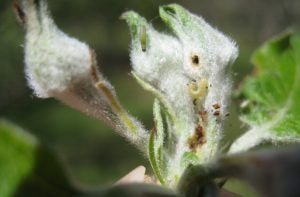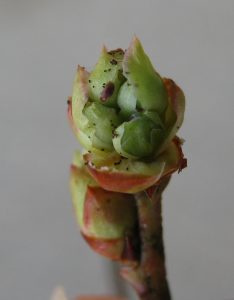April 11, 2019 Winter Moth Update
Winter moth eggs started hatching – right on schedule. Winter moth eggs start hatching soon after red maple trees reach full bloom and McIntosh apple trees reach green tip. Both those events happened this past week. I expect many eggs to hatch this weekend after temperatures get into the 60s.
I do not expect apple and blueberry growers or landscapers to spray to control winter moth caterpillars at this time, when eggs hatch. Rather I think the best approach is to wait a couple of weeks and see if there are enough winter moth caterpillars in buds to warrant spraying. The pictures below show apple buds and blueberry buds peeled open, exposing winter moth caterpillars and frass (insect droppings). It’s easier to find frass than caterpillars.
When caterpillars first hatch they are tiny and stay inside buds feeding. In a couple of weeks the caterpillars are larger and begin moving around from bud to bud or to leaves. That will be the best time to scout for caterpillars and apply an insecticide if needed. Nova Scotia apple growers use a threshold of 1 caterpillar per 10 fruit cluster buds before applying an insecticide. Fewer than 10% infested buds does not warrant spraying. If an insecticide treatment is needed, Bt insecticides are an excellent choice. Bt trade names include DiPel, Thuricide, Biobit and there are many others. Winter moth caterpillars are pretty easy to kill so most insecticides control them. Do not spray open flowers with insecticides. Even Captain Jack’s Deadbug Brew will kill bees for up to 3 hours after it is applied.
Figure 1: Winter moth caterpillars and frass feeding in apple flower buds at the tight cluster bud stage.
This flower bud cluster was pulled apart when looking for winter moth activity.
Figure 2: Blueberry flower bud peeled looking for winter moth caterpillars.
Scout developing buds in a couple of weeks to see if there are enough caterpillars to warrant spraying.
 Home
Home Browse
Browse Close
Close Events
Events Maps
Maps Email
Email Brightspace
Brightspace eCampus
eCampus




